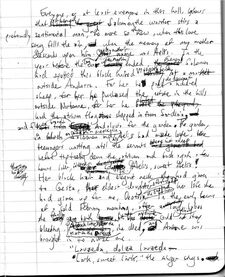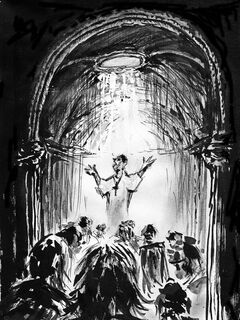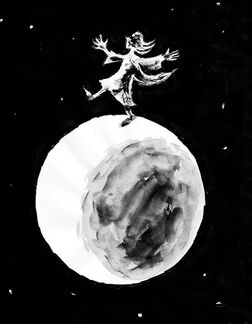 I never thought I would be writing a novel! Writing fiction, as I have found out, takes time. The main thing I have learned so far is to be patient. I finished my first draft of “Deotila and the Moon Lizard” seven years ago, in 2015. As you can see from the image on the left, I wrote the entire novel out by hand. Seven years later, I am on my seventh draft of the same novel! It takes time to create a story world. It takes time to find the heart of the story. And it takes time to learn the fine art of storytelling.  The other thing I’ve learned about writing fiction is the helpfulness of others. Whether it’s colleagues and teachers in writings groups or literary agents who rejected my queries, everyone has taught me something. I’ve even learned a thing or two from fellow artists on Instagram. The drawing you see here I made seven years ago for the first draft of “Deotila and the Moon Lizard.”
Many of us use the term “Middle Ages” without giving it a second thought. Where did this weird expression “Middle Ages” come from?
Interestingly, people during the Middle Ages never referred to their time as “the Middle Ages.” You can understand why. The expression implies a time period that didn’t quite make the grade. Middle Ages! It would be like people centuries from now referring to our time as the Primitive Internet Period or the Icky Eats Epoch. It was only after the Middle Ages ended that people during the Renaissance period came up with the label “Middle Ages.” Many during the Renaissance believed that Classical Antiquity was superior to the period that had come just before them, and so they called that period the Middle Ages. To help you picture the three time periods we’ve been thinking about, I have drawn a time line. Whereas Classical Antiquity and the Middle Ages lasted roughly the same amount of time, the Renaissance whizzed by in a little over a hundred years. ____________________|_________________________|____ ANTIQUITY MIDDLE AGES Renaissance And that’s how the belittling moniker “Middle Ages” came into existence! Thankfully, nowadays we look a little less disparagingly on the Middle Ages than people did during the Renaissance. We now know that the Middle Ages weren’t that “middling.” In fact, a lot of important developments happened during the Middle Ages, from mechanical clocks to multi-voice musical compositions. QUIZ #2 To help you think some more about this, I have listed three people below, one each from Antiquity, the Middle Ages and the Renaissance. Which one of the three lived during the Middle Ages?
For the correct answer, click on this button: You might be wondering what I mean by a novel “set in the Middle Ages.” A novel that is set in the Middle Ages falls into the category of historical fiction, distinct from fantasy.
Many fantasy novels are inspired by the Middle Ages, a period of European history that lasted from around 500 to 1500 C.E.—or A.D., if you’re feeling old-fashioned. Take the famous Harry Potter stories, for example, by acclaimed author J.K. Rowling. A lot in Harry’s world feels medieval, like the Hogwarts castle with its wizards and goblins. Even the spells at Hogwarts sound a lot like Latin, which was the international language used during the Middle Ages. Don’t be deceived by Rowling’s incredible story-telling, however! Hogwarts and all of its characters are entirely made-up. This is a work of fantasy. Other fantasy stories sound a little more medieval, like Cressida Cowell’s How to Train Your Dragon series or J.R.R. Tolkien’s Lord of the Rings novels, both of which became hit movies. Yet here again, both the characters and settings of these stories are completely fictional. I’m sorry to report that Hiccup Horrendous Haddock never existed; neither did Middle Earth or the Third Age! A story that is set in the Middle Ages, on the other hand, uses a real medieval time and place. This is historical fiction. A good example of historical fiction is Catherine, Called Birdy by Karen Cushman. While the main character Catherine never existed—that we know of—Catherine’s place and time did: central England of the late 1200s (near the end of the Middle Ages). So did quite a few of the secondary characters in Catherine, Called Birdy, like Dewi of Wales or Gilbert of Lincolnshire. Comment: What are some medieval novels that you've read in the historical fiction category? How about some fantasy ones? QUIZ #1 To help you think some more about this, here are three expressions that sound medieval from three different novels. Can you tell which one of the three was actually spoken in the Middle Ages? 1. Faeder ure 2. Expelliarmus 3. Khazad aimenu For the correct answer, click on the button below: |
John HainesI have been publishing in medieval studies for 20+ years. I started my career teaching elementary and middle school students. My favorite pastime at 10 years old was drawing cartoons! Archives
January 2022
Categories |
Proudly powered by Weebly









 RSS Feed
RSS Feed